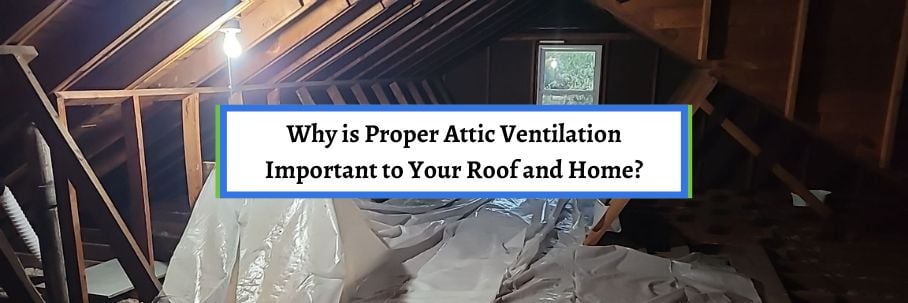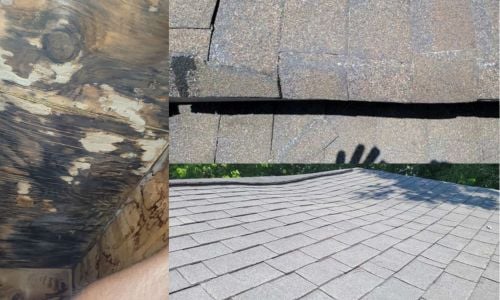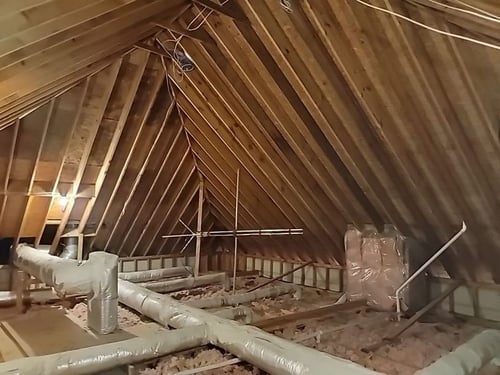Why is Proper Attic Ventilation Important to Your Roof and Home?

We’ve all been in an upstairs room during the summer and thought it was uncomfortably hot. You probably chalk it up to the temperatures outside, so you don’t think there’s necessarily a problem when your AC is running all day.
What you don’t know is that your attic’s ventilation system can cause this. Even worse, you’ll have roof problems that are much more severe than the high temperatures in your home.
That’s why you need to know why a properly ventilated attic is important for both your roof and home.
For over 30 years, the team at Bill Ragan Roofing has helped homeowners understand how their roof impacts the health of their home. Because your attic is a big piece of it, I’ll break down what happens when you don’t have the right amount of ventilation.
This article answers the following questions:
- Why is proper attic ventilation important to your roof and home?
- How can you tell if your attic isn’t properly ventilated?
- How much ventilation does your attic need?
Why is proper attic ventilation important to your roof and home?
Your attic’s ventilation system is the key to your home breathing properly. But if it's not breathing properly, you’re looking at expensive problems.
Let’s look at why proper attic ventilation is important to both your roof and home.
Attic ventilation affects your roof’s lifespan
While many factors impact a roof’s lifespan, proper attic ventilation is one of the most important. Without proper ventilation, trapped hot and cold air in the attic dramatically shortens your roof’s lifespan.
In the summer, the trapped heat literally burns your roof up, deteriorates adhesives in the decking, and leads to cracked or curled shingles. In the winter, condensation forms and gets trapped when the cold air in the attic meets the warm air from your home’s interior.
This leads to swelling that gives your roof decking a wavy look while also causing it to lose its load-bearing capacity and ability to hold nails. There’s also the potential for serious health hazards if mold/mildew can thrive.
No matter what time of year, I guarantee your roof will not reach its full potential if your attic isn’t properly ventilated.
Improper attic ventilation voids your material warranties
After installation, you’ll get two roof warranties to protect your investment. Well, an improperly ventilated attic voids the material warranties you get from the manufacturer.
Under normal circumstances, this warranty protects you if there are any problems with the materials’ functionality or manufacturer defects. But if your attic isn’t ventilated per their instructions, the warranty is immediately voided because your roof was installed incorrectly.
Unfortunately, this leaves you spending your own money to fix the problems.
Proper attic ventilation lowers your energy bills
If the temperature outside is 90°F, a poorly ventilated attic can reach temperatures as high as 170˚F, with even the attic floor reaching 140˚F from trapped heat. This causes the rooms below to get uncomfortable, where they won’t cool down enough until the sun goes down.
With it being so hot, your AC unit has to work harder and run more often to keep your home cool. As I said in the beginning, most homeowners chalk higher energy bills up to the temperature outside.
However, your home's high temperatures could be caused by poor ventilation. With a properly ventilated attic, you don’t have to worry about this happening.
In fact, your monthly energy bills should decrease and become stable.
How can you tell if your attic isn’t properly ventilated?
Unfortunately, improper attic ventilation is way too common in the roofing industry. Even worse, most homeowners don’t know about it until there’s already thousands of dollars worth of damage.
That’s why it helps to catch and take care of a poorly ventilated attic before it’s too late.
The signs of inadequate attic ventilation are:
- Upstairs rooms are hot during the summer months
- Ice damming occurs during the winter months
- Roof sagging and decking discoloration
- Mold forming and metal rusting in the attic
- Termite or other animal infestation
- Cracked or curling asphalt shingles

Unfortunately, some of the signs may not show up until there’s already noticeable damage, like roof sagging and damaged shingles. You’ll also have to pay for cleaning/extermination services for mold or insect infestation on top of fixing the ventilation.
But no matter what sign it is, you’re looking at getting another roof sooner rather than later if a poorly ventilated attic is left alone too long.
How much ventilation does your attic need?
It’s great to know why it’s important and the signs of a poorly ventilated attic. But how are you supposed to know how much venting your attic needs?
According to the International Residential Code (IRC), attics require a minimum of 1/150 of net free area (open area for air to pass through) for each square foot. Simply put, 1 square foot of net free area is required to ventilate every 150 square feet of attic space.

Let’s look at an example for an attic with 1500 square feet.
First, divide 1,500 by 150 to determine that you need 10 square feet of attic ventilation. Next, you have to convert the square footage to square inches to determine the number of vents needed for the space.
There are 144 square inches in a square foot, so you’ll multiply the square feet of attic ventilation needed by 144 to get the square inches. Using the example above, you would multiply 10 by 144 to get 1440 square inches of net free area needed.
With this number, you can now determine how many of the chosen exhaust vents (and accompanying intake vents) are needed to ventilate your attic properly. For this example, you would need 8 box vents for a passive attic ventilation system and 2 12” turbine vents for an active ventilation system.
What should you do about poor attic ventilation?
After reading this article, you know why your attic’s ventilation is important to both your roof and home. As I said, improper attic ventilation is way too common in the roofing industry.
If the damage is already done, there’s a high chance you’ll need a roof replacement. However, a reputable roofing contractor may be able to properly ventilate your attic before it’s too late.
Either way, you must find a roofer you can trust to ensure your attic gets the right amount of ventilation. This may seem easy, but there’s a reason this is one of the most common problems in the roofing industry.
And it all comes down to hiring a bad roofer or going cheap. The last thing I want is for this to happen to you.
That’s why I wrote another article with tips to help you find a great roofing contractor.
Check out 7 Tips to Find a Great Roofing Contractor to ensure you don’t get taken advantage of by the roofing industry.


